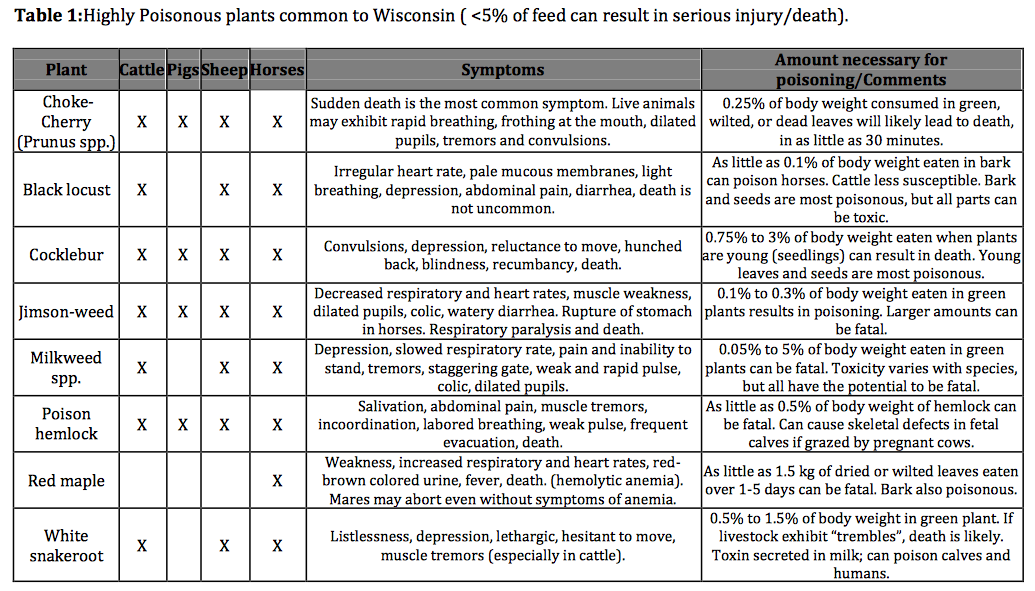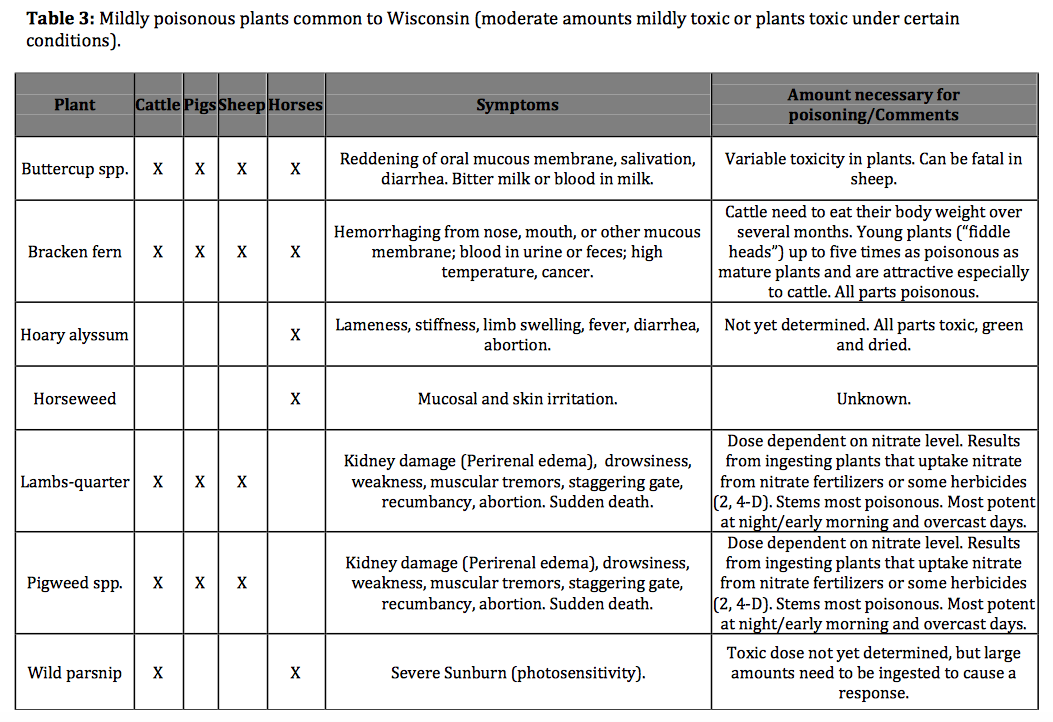Common Poisonous Plants of Concern for Wisconsin’s Livestock
by Anders Gurda and Mark Renz
Research Assistant and Extension Weed Scientist, University of Wisconsin-Madison
While most plants are safe for consumption by livestock, a few plant species can sicken or even kill animals. This publication overviews what poisonous plants are and under what conditions they can be toxic to livestock. A detailed list of common poisonous plants found in Wisconsin along with a description of the level of toxicity and resulting symptoms of ingestion is also included as a reference. If plant poisoning is suspected contact a veterinarian or other specialist immediately, as a rapid response is often required to prevent serious injury or death.
What Makes a Plant Poisonous?
The level of poisoning is determined by the amount of the toxic plant consumed, size and species of the animal, general health of the animal, and concentration of the toxin in the plant part. Symptoms may vary from the inability to perform to fullest potential to more serious manifestations, including slobbering, tremors, lack of coordination, erratic behavior, convulsions, or even sudden death. The level of toxicity in animals can vary over time due to the irregularity in animal ingestion, but also can be due to the variability in the amount of the toxic compound present in a plant. The presence of a toxic compound can vary dramatically depending on environmental conditions, management of the pasture, and even can be dependent on the plant part that is eaten (e.g. leaves, stems, roots, fruit, and even seeds). Thus toxicity is the result of many factors that can make diagnosis and determination of the level of seriousness difficult to determine. For simplicity we separate poisonous plants common to the upper Midwest into three categories:
- Highly toxic – small amounts (< 5% of feed) can result in serious injury/death.
- Moderately toxic – moderate amounts (> 5% – 25%) can result in injury/death.
- Mildly toxic – under certain environmental or management conditions these plants can be toxic.
When Should I be Cautious?
Fortunately the concern about toxicity is often a result of specific situations. Understanding what conditions can lead to plant poisoning can help reduce the risk of harm or death in susceptible herds. If any of these issues apply to you we recommend management practices to alleviate poisonous plants of concern.
First grazing in the spring.
When animals are put onto pasture for the first time in spring, poisonous plant tissue is young and more palatable. Livestock can feed on these plants at this time, especially if other desirable forage (e.g. forage grasses) hasn’t started to grow. To avoid this scenario we recommend controlling poisonous plants or not allowing animals into these areas until ample desirable forage is present to reduce the risk of animals feeding on poisonous plants.
Limited desirable forage available.
When animals are hungry, for any number of reasons, their selectivity decreases and they may eat plants they’d otherwise avoid. Make sure adequate forage is available, especially when poisonous plants are present. This is common especially under drought conditions, in the fall, or when pastures are overgrazed.
After an herbicide application.
Many weeds are not palatable and are avoided, but after an herbicide application their palatability can increase dramatically. If poisonous plants are treated with an herbicide we recommend not grazing for at least a 14-day period to avoid this occurrence. Read the product label for more specific recommendations and always follow label directions.
After application of nitrogen.
Fields with an abundance of nitrate-accumulating plants including pigweeds, common lamb’s quarters, and common ragweed can become toxic after fields are fertilized or following drought conditions. These common weeds take up excessive nitrogen and convert it to nitrate. If enough of these weeds are eaten this can result in nitrate toxicity. If these weeds are present and consist of at least 20% of the feed in a fertilized field, they should be controlled before allowing animals to graze.
Yard waste/clippings.
Many ornamental shrubs and plants are both highly toxic and palatable to livestock. Avoid feeding or dumping yard waste/clippings into pastures or animal holding areas, as this is one of the most common scenarios for livestock poisoning in the Upper Midwest.
Animals unfamiliar to a pasture or other area.
Animals that are being boarded at a new location are often susceptible to poisoning. When grazing a new area or newly seeded pasture, introduce animals gradually and monitor for any physical changes or change in behavior.
Toxic plants in harvested forages.
Few options exist for preventing the presence of poisonous plants in purchased hay. To make matters worse it is difficult for animals to avoid poisonous plants when they are dried and mixed with desirable forage. Knowledge of the source of the hay is the only realistic way to prevent this situation.
Common Poisonous Plants in Wisconsin
Prevention is always the best policy and the purpose of this paper is to point out some of the plants that are potentially harmful to livestock so that measures to avoid or at least minimize animal exposure. If control measures are needed, contact your county agricultural extension educator for assistance. If animals exhibit unusual symptoms, call a veterinarian.








